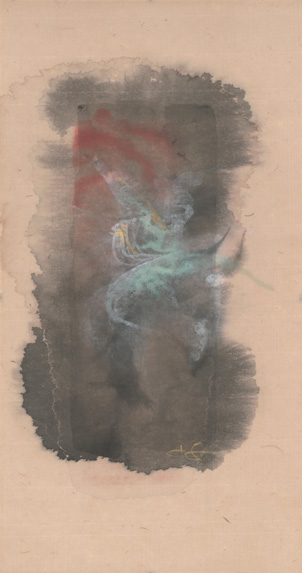|
数寄和 |
2016/11/8(火) – 11/19(土) |
トークショー 2016/11/9(水) 16:00 – 聞き手:小野塚 力(国文学研究者・日本キリスト教文学会会員)
パーティ 2016/11/10(木) 18:00 –
伝統的製法で漉いた楮紙に制作した作品をモダンな掛軸に仕立てて発表します。

マコトフジムラ Makoto Fujimura
1985年から1992年まで、東京藝術大学大学院 博士課程・加山又造、稗田一穂研究室にて修学する(文部省国際奨学生)。国際的な芸術活動により、2003年から2009年まで、ホワイトハウス文化担当顧問に任命され、アメリカ政府の文化芸術推進方針の策定に携わった。2015年よりロサンジェルスにあるフラー神学校の文化施設であるブレム・センターのセンター長となる。著書には、“Refractions: A Journey of Faith, Art and Culture,”(訳:リフレクション:信仰、アート、文化への旅)は、あらゆるバックグランドを持つ人々の会話、文化や芸術、人間論に対する瞑想を束ねたエッセイである。また、クロスウェイ出版が、欽定訳発刊400年を記念して発刊した「4つの福音書」には、フジムラ氏が聖なる御言葉をモチーフとして描いた絵が挿入されている。2011年にはFujimura Instituteを開設。ベルへブン大学(2011年)、バイオラ大学(2012年)、ロアノークカレッジ(2015年)より、芸術名誉博士号が与えられた。2016年5月アメリカで「Silence and Beauty」を出版。日本語版は晶文社より「沈黙と美」として2016年冬に出版予定。
マコトフジムラ「十一月の花」をめぐって
温室などを別にして、十一月に咲く花はあまりないだろう。季節としての十一月、事物としての花。相反する性質をもつ二つの言葉が、今回の個展のタイトルになっている。もし、十一月に花が咲くことがあっても、すぐに枯れてしまうだろう。だが、瞬間的なものであったとしても、花は咲く、咲いたのだ。継続しない瞬間的なものであったとしても、開花するものであってほしい。画家は、花を描きながら、花ではないものを描いている。
マコトフジムラ氏から、画集「GoldenSea」をみせていただいた。マコトフジムラ氏は、日本画家である。だが、画集に収録されている作品群は、日本画の素材で描かれた日本画以外のなにか、だった。初期作品は、明らかな風景描写がなされているものもあり、段階的にすべてが融和し、赤や青、金色、黒にまとめられていく過程を認めることができた。私がかつて見た「神の窓」にもみられる傾向だが、画家は、作品になにかを閉じ込めようとしている。私には、それは、言葉にできない世界、定義できない世界のように感じられる。こうした世界を観る画家は、共有できない世界、間接的にしか表現できない世界を生きているのだ。
「十一月の花」は、掛軸、和紙といった素材にあわせた世界を画家は選択している。結果、会場内に立ち上がる空気感は、茶室のような和のテイストが濃厚なものとなった。私には画家が、素材を通して東洋的なエッセンスを把握した結果のように感じられる。省くことで示す、余白を使った暗示である。
空白は、作品の沈黙を促す。鑑賞者は、作品の沈黙を補完するために、さまざまな方向性から作品の解析を開始する。結果、得られた感慨は、個人毎に異なるものが拡がり、鑑賞者毎の作品をめぐる物語が誕生する。
抽象芸術作品の本質は、この多義性にある。
わたしのなかに広がった「十一月の花」の世界は、向う側を花を通して感じながら、垣間見る彼方への光のようなものとなった。花は枯れるまでに一度は必ず、太陽に向かう。私はこの一瞬の邂逅に画家の救いへの意識をみる。抵抗と祈り。画家の世界への思いを、私はこの二つの要素で把握してみたい。
小野塚 力(国文学研究者・日本キリスト教文学会会員)
Currently, we are hosting the solo exhibition of Makoto Fujimura ‘November Flowers’ at Nishiogi, Sukiwa. Mr. Riki Onozuka, a researcher of Japanese literature, gave us a review of the exhibition. Please take a look if you are interested in the exhibition, the artist, or if you have already seen the exhibition.
Mr.Onozuka also helped us as an interviewer during the talk show on the 9th. The pictures were taken during the talk show.
Regarding ‘November Flowers’ by Makoto Fujimura
Except for those grown in greenhouses, flowers that blossom in November are quite rare. November is a season, and a flower is a living thing. These two words with contrasting properties were chosen as the title for this exhibition. Even if there was a flower which blossomed in November, it would probably die very quickly. It may be only an instant, but flowers do blossom, and they certainly did blossom. I still wish for flowers to blossom even if it is an ephemeral event. While the artist is painting a flower, he is expressing something other than a flower.
I had the pleasure of being shown the art book ‘Gloden Sea’ from Mr. Makoto Fujimura. Mr. Makoto Fujimura is an artist of Japanese art. The art work in the book was something different from Japanese art, while still being made from Japanese art materials. The initial works included paintings which I could clearly identify such as landscapes, but gradually everything harmonized, and I could see the process where it eventually settled as red, blue, gold, and black. As I previously saw in the “A Window of God” (note: Mr. Onozuka first encountered Mr. Fujimura’s work at a collector’s house, where “A Window of God” was showcased), it seems that the artist is trying to trap something into, and through, the art work: I feel that it is a world which cannot be expressed in words, and something which cannot be defined. An artist who sees such a world knows that such a reality cannot be shared readily and that can only be expressed indirectly.
In ‘November Flowers’, the artist selects a world which matches the materials such as kakejiku(hanging scrolls) and washi (Japanese paper). As a result, the atmosphere that surrounds the exhibit space is rich in Japanese history, like a tea room (chashitsu). I feel that it is a result of the artist grasping the Eastern essence through the materials: an implication from blank spaces which is created by omitting and negating.
Blank spaces bring out silence in an art work. In order to compensate for this silence, the observer starts to analyze the work from different angles. As a result, different deep emotions develop for each person, and each observer creates a different story behind the art work.
The essence of abstract art lies in this ambiguity.
The world of ‘November Flowers’ that I absorbed was another world which was felt through flowers, and that became like a light that shone from a far distance. A flower faces the sun at least once before it dies. I see this immediate encounter as the artist’s consciousness toward hope, resistance and prayer. The work invites the viewer to the artist’s thoughts filled with such a potential.
展示風景


